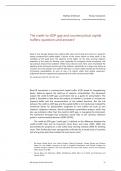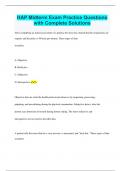Mathias Drehmann Kostas Tsatsaronis
mathias.drehmann@bis.org konstantinos.tsatsaronis@bis.org
The credit-to-GDP gap and countercyclical capital
buffers: questions and answers1
Basel III uses the gap between the credit-to-GDP ratio and its long-term trend as a guide for
setting countercyclical capital buffers. Criticism of this choice centres on three areas: (i) the
suitability of the guide given the objective of the buffer; (ii) the early warning indicator
properties of the guide for banking crises (especially for emerging market economies); and
(iii) practical measurement problems. While many criticisms have merit, some misinterpret the
objective of the instrument and the role of the indicator. Historically, for a large cross section of
countries and crisis episodes, the credit-to-GDP gap is a robust single indicator for the build-up
of financial vulnerabilities. As such, its role is to inform, rather than dictate, supervisors’
judgmental decisions regarding the appropriate level of the countercyclical buffer.
JEL classification: E44, E51, E61, G01, G21.
Basel III introduced a countercyclical capital buffer (CCB) aimed at strengthening
banks’ defences against the build-up of systemic vulnerabilities. The framework
assigns the credit-to-GDP gap a prominent role as a guide for policymakers. The
guide is intended to help frame the analysis of whether to activate or increase the
required buffer and the communication of the related decisions. But the link
between the credit-to-GDP gap and the capital buffer is not mechanical. Instead the
framework allows for policymakers’ judgment on how buffers are built up and
released. Judgment, however, should complement quantitative analysis, which may
also use indicators other than the credit-to-GDP gap, in managing the instrument.
The framework envisages that authorities would refer to the common reference
guide in communicating decisions (BCBS (2010)).
The credit-to-GDP gap (“credit gap”) is defined as the difference between the
credit-to-GDP ratio and its long-term trend. Borio and Lowe (2002, 2004) first
documented its property as a very useful early warning indicator (EWI) for banking
crises. Their finding has been subsequently confirmed for a broad array of countries
and a long time span that includes the most recent crisis.2
1
We thank Claudio Borio, Juan Carlos Crisanto, Dietrich Domanski, Tamara Gomes and Christian
Upper for very helpful comments, as well as Angelika Donaubauer and Michela Scatigna for
excellent research assistance. The views expressed are those of the authors and do not necessarily
reflect those of the BIS.
2
See eg Borio and Drehmann (2009), FitchRatings (2010), Behn et al (2013) and Drehmann and
Juselius (2014).
BIS Quarterly Review, March 2014 55
, The credit-to-GDP gap has received attention from academics and
practitioners. Some have confirmed its usefulness as an indicator of financial
vulnerabilities, but others have been more critical about its properties. The criticisms
of the credit-to-GDP gap follow three main lines: (i) the credit gap is not a good
guide for setting the buffer because it can lead to decisions that conflict with the
CCB’s objective; (ii) the credit gap is not the best EWI for banking crises, especially
in the case of emerging market economies; and (iii) the credit gap has measurement
problems.
The purpose of this article is to review these criticisms in the context of the role
of the indicator within the CCB framework. In what follows, we address each area of
criticism in a separate section. We argue that many criticisms, while factually
accurate, misinterpret the role of the credit gap as a common reference guide for
CCB decisions. We also review and extend the evidence on the reliability of the
credit gap as an EWI for banking crises, which is essential for an instrument aimed
at protecting banks from the build-up of aggregate vulnerabilities. We also discuss
some of the practical measurement problems that arise in the calculation of the
credit gap.
The credit-to-GDP gap and the objective of the CCB
Taking a broad perspective, some critics argue that the credit-to-GDP gap is
unsuited as guide for the CCB because it does not conform to the buffer’s objective.
In particular, they suggest that the guide might trigger procyclical changes in the
buffer, that is, lead to increases in bank capital during periods of recession and
declines in periods of economic expansion. A related, but more conceptual, critique
is that the credit gap does not correspond to an equilibrium notion of credit in the
economy.
The main objective of the CCB is to protect banks from the effects of the
financial cycle (BCBS (2010, page 1)). The idea is to boost capital in periods when
aggregate vulnerabilities are building up. Buffers accumulated in good times can
then be released (ie used up) in bad times, helping to absorb losses.
Importantly, the relevant cycle for the instrument is not the business cycle but
the “financial cycle” – the boom and bust cycles that characterise the financial
system. Aikman et al (2010), Claessens et al (2011) and Drehmann et al (2012)
document that financial variables (in particular, credit and property prices) have
pronounced and largely coincident cycles. These financial cycles have greater
amplitude and duration than the fluctuations in economic activity, known as the
business cycle. Graph 1 (taken from Drehmann et al (2012)) illustrates this for the
United States. More often than not, financial cycle peaks are punctuated by banking
crises. The CCB aims to help banks survive such episodes. However, the CCB is not a
tool intended to actively manage the cycle. The Basel Committee notes the
instrument’s “potential moderating effect on the build-up phase of the credit cycle”
but characterises this as no more than “a positive side benefit” (BCBS (2010, page 1)).
Repullo and Saurina (2011) argue that the credit gap is not the right anchor for
the buffer because it moves countercyclically with GDP growth. Their argument
places the business cycle centre stage and suggests that a CCB driven by the credit
gap would exacerbate rather than smooth fluctuations in GDP. There are both
statistical and economic counterarguments against this criticism.
56 BIS Quarterly Review, March 2014
, The financial and business cycles in the United States Graph 1
0.6
0.4
0.2
0.0
–0.2
–0.4
–0.6
72 75 78 81 84 87 90 93 96 99 02 05 08 11
1 2
Financial cycle Business cycle NBER recessions
1
The line traces the financial cycle measured as the average of the medium-term cycle in the component series using frequency-based
filters. 2 The line traces the GDP cycle identified by the traditional shorter-term frequency filter used to measure the business cycle.
Source: Drehmann et al (2012).
From a statistical point of view, the criticism regarding the correlation between
the credit gap and real GDP growth is only partly correct. This correlation is indeed
negative across a panel of 53 countries over the period 1980–2013 but small in size
(Table 1, first column).3 Closer examination of the data reveals that the negative
sign is driven primarily by periods when the information from the indicator is of no
consequence for the capital buffer. These are either periods during which the credit
gap was low and the capital buffer would not have been activated, or periods
following crises when the buffer would have been released. Excluding these periods
renders the correlation either positive or statistically indistinguishable from zero
(Table 1, second and third columns).
More importantly, the starting point of the criticism is incorrect. The value of a
guide for the CCB must be assessed against the buffer’s economic objectives, which
is not to manage the business cycle, but to defend banks against the financial cycle.
To be sure, the lack of coincidence between financial and business cycles does
raise challenges. There have been periods when the credit gap would have
suggested increasing capital buffers in the midst of a recession. And a decision to
increase the countercyclical buffer in such times, even if justified on prudential
grounds, may meet with stiff political resistance. But, even in these circumstances, it
is unclear how strong the real impact on GDP would be: the empirical literature fails
to provide evidence of a strong link between higher bank capital requirements and
lower growth. Recent studies put the median estimates for the impact of a
1 percentage point increase in capital requirements on GDP in the range of 0.1 to
0.2 percentage points, while the long-term impact of better capitalised banks on
economic output is estimated to be positive (BCBS (2010)).4
Edge and Meisenzahl (2011) as well as Buncic and Melecky (2013) point out
that the credit-to-GDP gap is not necessarily an equilibrium notion of credit for the
economy. These authors agree with the idea that the CCB should protect banks
3
See the next section for a more detailed description of the data used in this article.
4
For a recent overview, see CGFS (2012).
BIS Quarterly Review, March 2014 57





